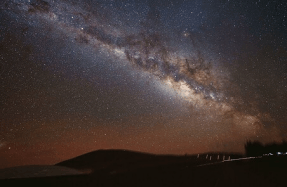
Every 133 years, Comet Swift-Tuttle makes its return to the inner Solar System. It last made an appearance in 1992. Each time it nears the Sun, this speeding ball of ice, rock and dust grows a tail that deposits a glittering trail in its wake. Every year our planet moves through this, causing the dust particles left behind to come crashing through the atmosphere. Most of them are tiny, but as they burn up 100 kilometres (60 miles) above our heads they leave a bright streak of light. We call this a meteor, or ‘shooting star’. The space between the planets and around Earth’s orbit is full of dust, so every night there will be one or two random meteors. When Earth travels through the cloudy trail of dust left by a comet such as Swift-Tuttle, there are so many meteors that it’s described as a meteor shower. If you’ve seen one, you’ll know that meteor showers are among the most spectacular sights in the night sky.
There are many meteor showers each year, some better than others. The dust left by Swift-Tuttle forms the Perseid meteor shower, which runs from 17 July to 24 Either side of this peak, the number of meteors drops off – imagine the trail left by the comet beginning to of the trail, and the most active meteor showers can produce more than 100 shooting stars per hour.






